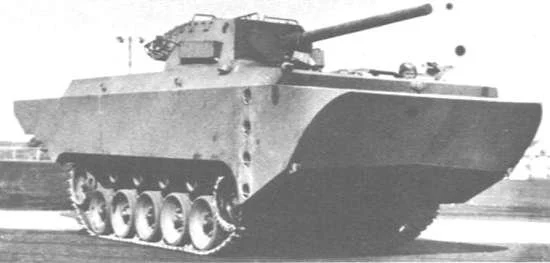
T86 GMC (Amphibious) showing new flotation hull on M18 chassis.
T87 GMC (Amphibious) with 105mm howitzer and modified hull.
Combat experience in the Pacific led to several experiments and projects to give amphibious capability to US AFVs.
As a result of meetings held on the Ritchie Project in December 1943 and January 1944, the National Defense Research Council undertook to develop an amphibious gun motor carriage created from the M18. This involved removal of the M18 hull plate down to the sponson line and substituting a larger amphibious hull of lighter construction. The reduction gear final drive gear ratio was lowered and suspension changes were made to accommodate an M24 Light Tank type 21 inch track This vehicle was called the T86 Amphibious Gun Motor Carriage
The original T86 continued the 14-inch track of the M18 because the new tracks were not ready in time Marmon-Herrington was given the contract in January 1944 to build three pilots. The T86 was track propelled the T86E1 had twin 26-inch screws driven from a rear transfer case. The screws were in tunnels with twin cable-controlled rudders behind them. The best of these two propulsion methods was to be used in the T87. This proved to be the track type, and an improved track was incorporated in the T87 along with detail changes to the hull.
The T86 (sometimes called the Esch Device) was designed to provide a vehicle with high firepower and good performance on both land and water. Land performance turned out to be practically the same as that of the M18. It floated with about 15 inches freeboard and it had a speed of 4-6 m.ph in water using the standard M18 track. The vehicle later was modified to add a third steering position just forward of the turret and cutting off the forward corners of the deck, adding vision blocks in both corners and additional periscopes for the driver. The T86E1 began undergoing tests late in April 1944 It weighed 23 tons and developed a speed in water of 6.2 m.p.h. with no appreciable reduction in land speed The T86E1 later was modified by removing one screw.
The third pilot was to incorporate the best features of both but the armament was to be a 105-mm howitzer.
This was the T87.
The T87 with the 105-mm. howitzer weighed 1,000 pounds less than the T86E1 and was 2ft 3in shorter.
The T87 appeared in December 1944 and was still undergoing trials at the cessation of hostilities, after which it was cancelled. The T87 had the same 105mm howitzer as the T88 while the T86/T86E1 had the 76mm gun of the M18. The T87 had a slightly shorter hull. All these prototypes proved satisfactory on test with a good performance in surf. However, forward vision was generally poor due to the hull shape. In addition it was found necessary to add cable-controlled rudders at the hull rear to assist steering.
It was track propelled Marmon-Herrington also modified for the Navy Bureau of Ships an M18 into what was called the LVT 76-mm Amphibious Gun Carrier. Curiously, electrolytic action between dissimilar metals caused a fabrication problem so this vehicle was only some 30 per cent completed. It was to have had a Ford 500 h. p. V-8 engine and a Jered No 900 transmission, but these were never installed.
Variation/prototype on T87 with wadding trunk and detachable pontoon. One of the attempts to adapt the M18 for amphibious operations was the development of the Ritchie T7 swimming device, a set of pontoons and associated trunks. This shows the cumbersome affair attached to one of the T88 pilots. A total of 250 sets of this kit were manufactured, but they were never used in combat.
Variation/prototype on T86 with overhead turret protection.